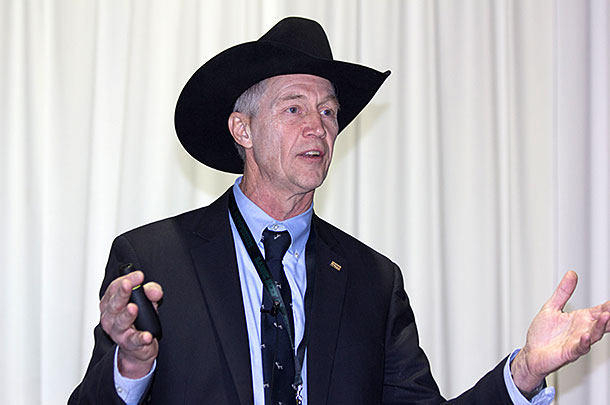Frank Garry, a veterinarian and coordinator for Colorado State University’s Integrated Livestock Management, doesn’t mince words on the critical steps needed to manage compromised calves at birth.
Speaking to the Range Beef Cow Symposium in Loveland, Colorado, on Nov. 18, Garry said beef calf death loss is a significant risk to the operation. And the key to reducing that risk is a vigilant producer eyeing the new calves.
“The transition from living inside the uterus to living on the outside is the single most major transition of physiological function that an animal will ever make, literally until the time it dies,” Garry said.
“So what I’m hoping to do is crystalize for you why you should be more active, and more consistent, and more frequently applying simple nursing care things that help compromised calves.”
From the moment the calf hits the ground, a rapid sequence of events unfolds in the calf’s organs and anatomy. Some changes happen in the first two minutes; others adapt over the coming three days.
First is the respiratory change, followed by cardiovascular movement. The calf has never breathed, and the first breath is the physiological kick start. These organs have to expand since they are connected to pulmonary vessels that push blood into the heart and lungs, allowing oxygen to also go to the lungs and heart.
Since the calf can’t breath in utero, it takes large breaths to get blood going to those tightened vessels.
“So we’ve got this vicious cycle: If your calf doesn’t have oxygen, it doesn’t have strength; it doesn’t have strength, it can’t move; it can’t move very well, it can’t stretch the chest and can’t get oxygen,” Garry said.

The calf is also experiencing metabolic energy changes, moving from energy supplied by the mother to starting to create energy on its own.
There are fluid balance changes, as the calf moves out of a “swimming pool environment” in the uterus to a radical shift of less fluid in their tissue and circulation.
“Calves are always born with less fluid volume than they really need to maintain really good blood pressure,” Garry explained. “They’ve spent their entire system in a swimming pool environment. When you get out of a pool, you’re going to see your temperature drop and you’re going to lose fluids.”
This also ties to a thermoregulation change in the calf’s body. Inside the uterus, “it resides in a contained thermal environment of 102 degrees.” Then it’s exposed to elements, “and it better be able to generate some heat, or it’s going to die.”
Finally, there’s a muscular-skeletal pressure being thrust upon the calf as it must begin movement outside the womb. “It’s never done this before in its life, and it’s never used its neurological function to sense its surroundings – to find a teat, seek for it and do something.”
Warm them up
To help calves with all of these various transitions, ranchers need to know the protocols that can help in the early stages of life.
Non-shivering calves start to generate heat with blood shunted through brown fat that converts it to higher body temperature. As oxygen moves into the bloodstream, this generation of heat begins.
Calves will begin shivering as a way to increase heat – anywhere from 33 to 100 percent more. Calves that are hypoxemic do not shiver.
Physical activity, which begins as the calf tries to stand, can increase heat by another 33 to 100 percent. Without movement, the calf will lie down and be at risk for frostbite or scours.
“You don’t need equipment at this stage,” Garry said. “Many producers don’t take internal temperature on calves. Of all the measurements you could do, do that.”
“You need to look at the calf and ask: Is it lethargic? Is it inactive? Has it stood in a reasonable amount of time? Is it sucking? How long did it take to nurse?” ![]()
Other timetables to follow with calves:
- Within three minutes, its head is upright.
- Within five minutes, it is in sternal recumbence on its stomach.
- Within 20 minutes, it’s trying to stand.
- Within 60 minutes, it’s standing.
- Within two hours, it’s actively sucking.
PHOTO 1: For the calf to survive in harsh elements, it requires the ability to stand within an hour and the ability to take nourishment within two hours.
PHOTO 2: Frank Garry, DVM, of Colorado State University addresses the audience at the Range Beef Cow Symposium. Staff photos.







